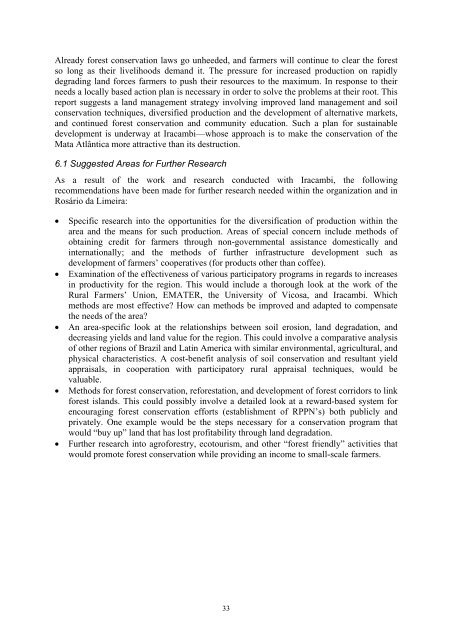Deforestation, Coffee Cultivation, and Land Degradation ... - lumes
Deforestation, Coffee Cultivation, and Land Degradation ... - lumes
Deforestation, Coffee Cultivation, and Land Degradation ... - lumes
Create successful ePaper yourself
Turn your PDF publications into a flip-book with our unique Google optimized e-Paper software.
Already forest conservation laws go unheeded, <strong>and</strong> farmers will continue to clear the forestso long as their livelihoods dem<strong>and</strong> it. The pressure for increased production on rapidlydegrading l<strong>and</strong> forces farmers to push their resources to the maximum. In response to theirneeds a locally based action plan is necessary in order to solve the problems at their root. Thisreport suggests a l<strong>and</strong> management strategy involving improved l<strong>and</strong> management <strong>and</strong> soilconservation techniques, diversified production <strong>and</strong> the development of alternative markets,<strong>and</strong> continued forest conservation <strong>and</strong> community education. Such a plan for sustainabledevelopment is underway at Iracambi—whose approach is to make the conservation of theMata Atlântica more attractive than its destruction.6.1 Suggested Areas for Further ResearchAs a result of the work <strong>and</strong> research conducted with Iracambi, the followingrecommendations have been made for further research needed within the organization <strong>and</strong> inRosário da Limeira:• Specific research into the opportunities for the diversification of production within thearea <strong>and</strong> the means for such production. Areas of special concern include methods ofobtaining credit for farmers through non-governmental assistance domestically <strong>and</strong>internationally; <strong>and</strong> the methods of further infrastructure development such asdevelopment of farmers’ cooperatives (for products other than coffee).• Examination of the effectiveness of various participatory programs in regards to increasesin productivity for the region. This would include a thorough look at the work of theRural Farmers’ Union, EMATER, the University of Vicosa, <strong>and</strong> Iracambi. Whichmethods are most effective? How can methods be improved <strong>and</strong> adapted to compensatethe needs of the area?• An area-specific look at the relationships between soil erosion, l<strong>and</strong> degradation, <strong>and</strong>decreasing yields <strong>and</strong> l<strong>and</strong> value for the region. This could involve a comparative analysisof other regions of Brazil <strong>and</strong> Latin America with similar environmental, agricultural, <strong>and</strong>physical characteristics. A cost-benefit analysis of soil conservation <strong>and</strong> resultant yieldappraisals, in cooperation with participatory rural appraisal techniques, would bevaluable.• Methods for forest conservation, reforestation, <strong>and</strong> development of forest corridors to linkforest isl<strong>and</strong>s. This could possibly involve a detailed look at a reward-based system forencouraging forest conservation efforts (establishment of RPPN’s) both publicly <strong>and</strong>privately. One example would be the steps necessary for a conservation program thatwould “buy up” l<strong>and</strong> that has lost profitability through l<strong>and</strong> degradation.• Further research into agroforestry, ecotourism, <strong>and</strong> other “forest friendly” activities thatwould promote forest conservation while providing an income to small-scale farmers.33
















